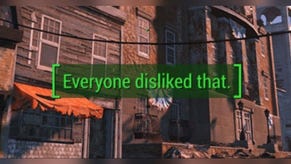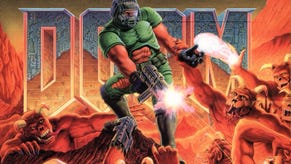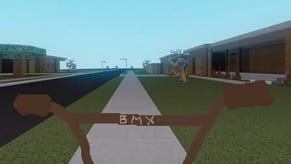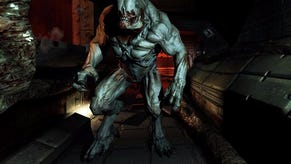Doom III: Single-Player
Right. That's it. London's too hot - we're off to Mars.
Order yours now from Simply Games.
It's hard to figure out what's more hellish. Being trapped indoors on a hot, sticky, humid London summer day at 32 degrees C, fighting off your body's desire to dissolve into a pool of salty ooze, or being trapped on a base on Mars in the future, fighting off an endless respawning succession of Satan's minions. The fact that we had to do both at the same time in order to get a review out on time simply made the experience all the more authentic. In our spare time, we sin for fun, so hell seems like our natural home; it's like playing tourist to your future.
Doom III kicks off with a knowing nod to Valve, with an opening sequence that bears more than passing resemblance to Half-Life but feels more like a fitting tribute to their excellent ideas than an all-out lift. Still, you can't help but smile as your grizzled, muscle bound marine arrives at work, faced with orders to go and see his superior, assorted grunting co-workers and jobsworths barking at you to get a move on or moaning about their lot at the UAC base.
Single white bad guy: seeks relic to enter the gates of hell
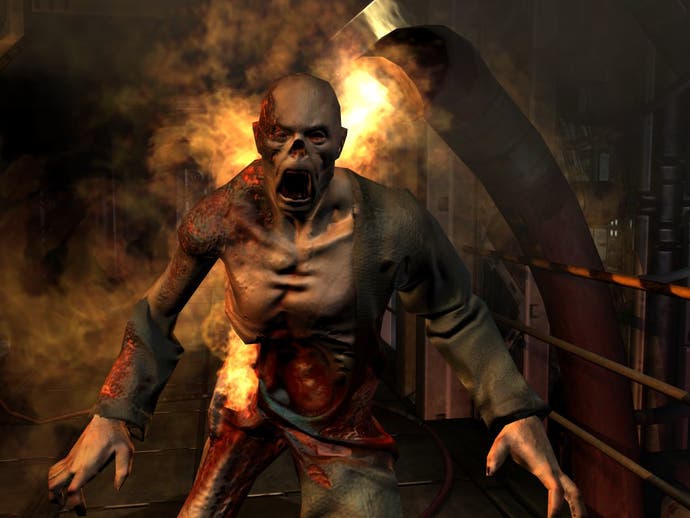
Of course, exactly to type, your initially humdrum arrival heralds the start of hell literally breaking loose. All but a handful of your colleagues are instantly turned into shambling Dawn Of The Dead extras, fixated on killing anything in sight, and suddenly your brief is to send a distress call, before eventually taking on the culprit - who happens to be the power-crazed boss of the base Malcolm Betruger. Now, where would videogames be without some megalomaniac let loose with supernatural powers, we often wonder? No-one expected anything different, of course, but rather than being a worthless over-the-top exercise in science fiction, the narrative is actually one of the game's strong points - but more of that later.
Ultimately the narrative's a sideshow to the main event. The reason Doom III's taken so long (over four years) to emerge is evidently the sheer amount of grunt work to get the tech in the state they wanted it. The result is largely magnificent - a true next-gen engine, and the sort that most serious PC gamers have been waiting years for; a game to truly test the capabilities of recent and forthcoming graphics cards, and an engine that fellow developers will be making games with for the next five years or so. For what seems like an age, PC games have been stuck in something of an incremental rut, but what id has produced consistently surprises with the grace and subtlety on what boils down to a very straightforward shooter - once you pick your jaw up off the floor and stop drooling at what's being displayed in front of your eyes.
Everywhere you look Doom III has improved on something incidental. Just take the environments. As samey as the interiors of a 22nd Century base inevitably become, it gets away with it by making every area feel alive. Every corridor, every office, every crawl space regardless of how bland has something going on inside it. A flickering light, a burst pipe pumping out steam, a PC monitor that you can actually read (and in many cases interact with), a smashed up fixture, a knocked over chair and discarded soft drink can. It no longer feels like a generic, tiled gaming environment that anyone could put together.
No wonder it took a gazillion man-years
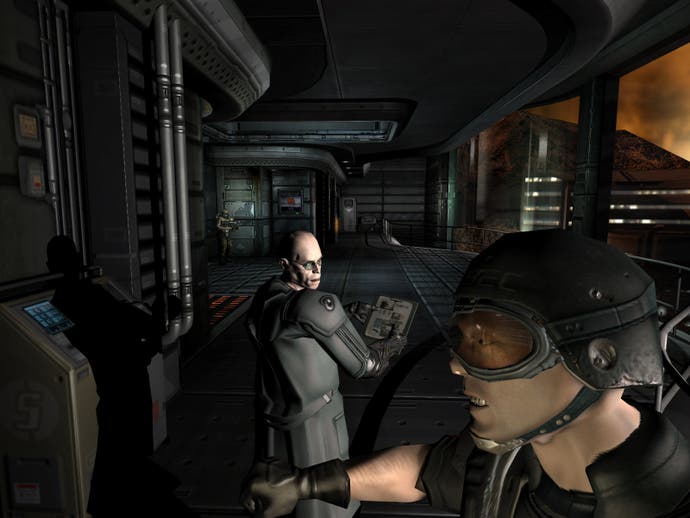
Almost every single environment feels hand crafted, thought through, built. At times it feels almost too real. Look through a window for the first time and see the distortion effect behind it. That, along with 1500 other things will jump out at you and make you go "ooh - look at that". Enter a connecting corridor and gaze out wide-eyed onto the rocky exteriors of the red planet with swirling dust and feel the sense of awe wash over you. You might as well be there. This could almost be the real thing. Doom III's biggest draw is the sense of heightened immersion. This isn't marketing bullshit anymore; at times you're no longer just playing a game. In your head, this could be Mars.
No amount of mental imagining via text-based narrative, or Hollywood movie blockbuster special effects, could replicate the sensation of being on that UAC base in Doom III just trudging around, alone, afraid. This is one of the greatest realisations of an interactive audio/visual experience. Ramp up the detail, buy a bigger screen, spec up the surround sound system, dim the lights. Doom III creates a special atmosphere of tension around every corner, and is exactly the sort of game you can see the audio/visual potential in - and as a result you won't mind spending money to make the most of it. To play it any other way would be like trying to play a guitar with one hand. Frankly, anyone interested owes it to themselves to make the most of what's on offer here. This, along with a bunch of other games coming soon, is a hardware company's wet dream.
Doom III starts out tight and enclosed. Enemies come at you in ones and two. It feels claustrophobic, like Resident Evil crossed with Aliens. Every fight in Doom III has you reeling on your heels; there's rarely enough firepower to just send them packing - and when there's a bunch of them, close quarters combat will have you facing hammer blows, claws and fireballs raining down, bluring your vision, accompanied by shrieks of menace and pain. You learn to back the hell off - Doom III is never an easy ride. Nevertheless, the challenge is a sound one, because you're simply revelling in the unprecedented level of detail packed into every creature, every survivor, and it only ever looks better the closer you get to them. The stills can never do them justice, but seeing them in motion is something else; not only are they designed to a level that's reaching perfection, but they're animated with such convincing fluidity it's hard to take it all in.
Architect of death wanted: must have designs on the soul
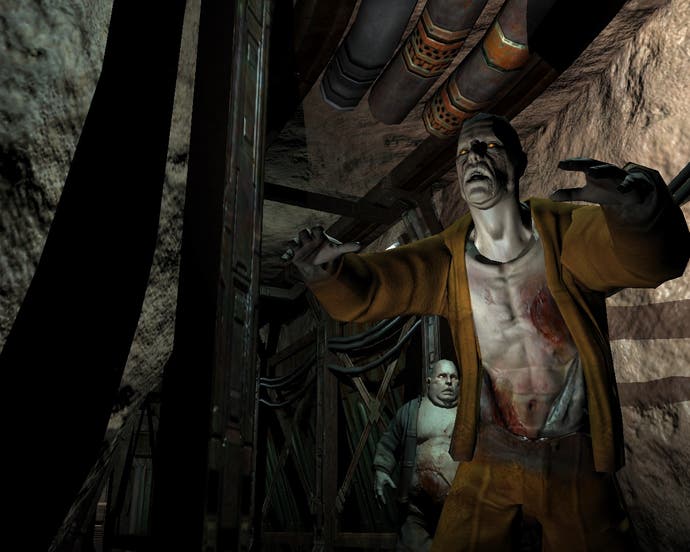
And the spectacle is heightened all the more by simply watching them recoil in accordance with the force delivered. A mere pistol shot might nudge them slightly, a shotgun might even blow their brains out close up, but whack a rocket at them, and the chances are they'll go flying with hapless velocity. The damage modelling isn't quite as expansive - in that you can't target individual limbs - but the force of destruction is no less spectacular once you see their skeleton dissolving with the shattering force of your blast. Add to that the celebrated lighting capabilities of the engine, which plays a huge part in the game. For much of the game you're in partial darkness, and Doom III makes the most of scaring the bejesus out of you, placing enemies where you least expect them, or saving them until you trigger them by picking up an innocuous object first. It's a cheap trick, but one that serves the game well by keeping the player in an almost perpetual state of fear. Eventually you almost just learn to be scared, be ready, reloaded and primed for another architect of death to have designs on your soul.
One of the hasty conclusions drawn about Doom III is the tightness of the environments, which leads to an initially un-Doom-like experience, where manageable clusters have replaced the relentless assault of the many, and downed enemies merely vanish into the ether - obviously a CPU saving tactic, but disappointing for those that like to see the fruits of their labours (especially given that this was one of the trademarks of the original). The UAC base could never be described as the most expansive location for a game, but as things progress, the architecture changes subtly, along with the enemies that populate it. At first corridors are low and narrow, and this gives as false impression, as it turns out. Not only does the terrain start deforming (sometimes right in front of your eyes), but the terrain changes altogether (no spoilers from us!) - dramatically. Suddenly it's like playing an entirely different game, and one where the odds are stacked firmly against you. One where the only hope is that you'll actually get good enough to figure it out, and it's at that point Doom III really clicks. Once you raise your game in the face of brutally hard odds, it's like old times again, only with the most impressive graphics engine ever.
Even the audio stands out as being exceptional. Whether via the means of surround sound or, our preference, through headphones, you're constantly struck by the attention to detail. Just wandering around, it's like everything has a sound. The intermittent blips of a nearby terminal, the whooshing of air from a pipe, the faint footsteps of an oncoming enemy on a metal walkway above you. Possibly more than even the visuals themselves, the audio fills in the mental gaps of what's going on, and cannot be underestimated as to its role in making Doom III what it is. And more. Praise be for the addition of quality voice acting - if only every game developer realised how important this is to the overall atmosphere and suspension of disbelief. In what is a relatively solitary game, you don't come across too many survivors, but when you do it's worth the wait - each is blessed with excellent lip synching and facial animation that allows id to dispense with the idea of ever having to resort to rendering cut-scenes out of the engine.
id in good story, shock!
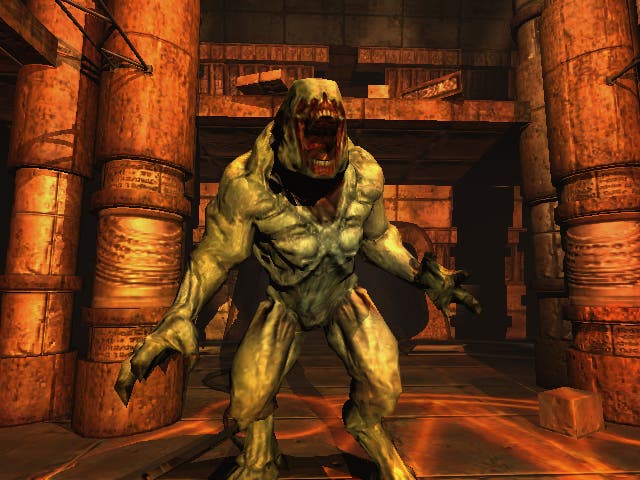
Even when things are getting lonely, the game's use of PDAs allows id to subtly tell a story in roughly the same manner that Capcom, Konami and Tecmo have been doing for years with their surivial horror game. In Doom III's case, instead of discarded notes and keys, the PDAs come with keycodes, security clearance, as well as their audio logs, emails and the odd videodisk lying around. Reading emails and listening to logs provides a unique insight into just how the base has ended up in this state in the first place, with many voicing concerns over security and a general dissatisfaction over many of the procedures leading up to the incident. Not only that, they often provide the combinations you need to access the many lockers around the base that provide crucial ammo, armour and health - often just when you need it most. All told, the narrative structure works well within the context of the incident, and although ultimately the concept of one man's megalomania causing havoc is hardly original, the execution makes it easy to forgive such an obvious route. And certainly, given that it's id's first attempt at injecting any kind of story element into one of its games, it's a big success, even if ultimately it hasn't quite got the imagination to come close to usurping some of its rivals in this respect.
Naturally, there have been complaints that Doom III doesn't do enough to take things forward, and in many respects those claims are hard to argue against. There are basic errors and omissions that seem unjustifiable. For example, why on earth couldn't there have been some sort of head mounted lamp? Forcing the player to ditch their weapon every time they need to illuminate the proceedings just seems daft - at least id could have compromised and made certain weapons one-handed (like the pistol or hand grenades). Other touches that seem standard in other games are also missing, such as being able to lean around corners, and adding other soldiers fighting on your side might have added personality and credibility. Small points, but things that would have made the game feel just a fraction better.
What many players will certainly end up arguing long and hard into the night over is whether Doom III's ostensibly old school, simple gameplay was the right direction to go in. Once the game opens up a little and becomes a little less like a survival horror FPS, the conclusion we came to by the end was that, yes, it definitely was the right decision. There's ultimately a place for all sorts of sub-genres to flourish within the broad bracket of first-person shooters, and to have strayed too far from the cherished Doom brand and all that it stands for would have been considered sacrilege. For the purposes of bringing the Doom gameplay up to date, after a questionable early portion of the game id absolutely hits the sweet spot between adding in the new features we know and love; the physics, the narrative, the benchmark audio/visual elements, while staying true to the relentless assault on the senses that the previous Doom games fostered.
Doomed to be Doom
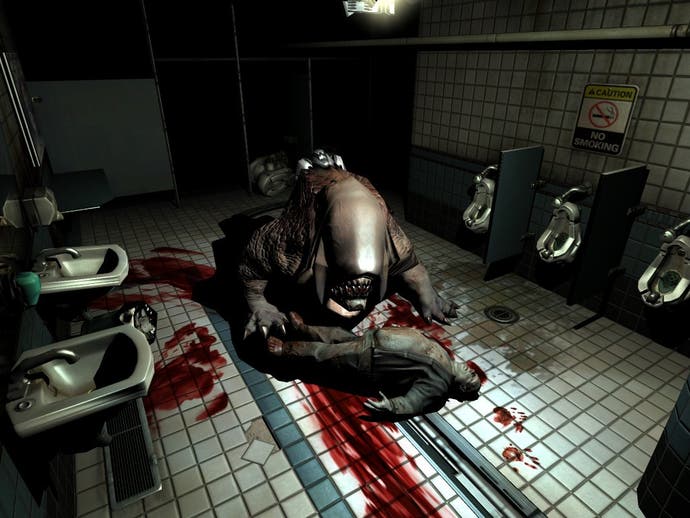
Taking Doom III out of context and isolation is somewhat easier to do. It is not a varied game, and it's certainly about as far away from being original as you could get. In simple terms it's just one unending succession of locked door/find key tasks populated by the endless repetition of killing everything that gets in your way - but isn't that exactly what id games are supposed to do? Sometimes it doesfeel a little samey, although it would be harsh to interpret that as boring; there's simply too much going on in the environment for it to ever stoop to being that. It would have been nice to maybe have more than three or four extremely simple puzzles in the entire game, and to that end Doom III does little, if anything, to update the status quo. A bored, apathetic cynic might take a weary glance at Doom III and mutter sarcastically something along the lines of "ooh pretty graphics, shooting, zzzzzz, really exciting". Yes, if you want to completely miss the point about Doom III's appeal, then it is easy to sum it up into digestible, cynical chunks. More justifiably, you might also baulk at the amount of money it might take you to spec your PC and audio/visual equipment up to the 'right' levels. For the sake of one game, yes, it could well be out of the question, but bear in mind there are other games around the corner that will demand the same...
It may not feel like it's taking gaming forward to any appreciable degree in terms of astounding new ideas, but when it's as all round immersive and entertaining, who cares? The thrill of Doom III is simply that id has not only created something genuinely stand-out impressive on a technical level, but has gone on to create a beautifully unpretentious game that feels at home with itself in that it's not trying to be something it isn't. At once retro in its simplicity, yet managing to create a compelling world that drags you in, Doom III dissolves your apathy by taking you on the kind of harrowing journey in the unknown that all the best shooters should. Doom III feels like glimpse into the future of videogaming but without forgetting its past, and for that, Doom fans will be thankful. It's best not to think of what Doom III isn't or what it should have been; far better to celebrate what it is - a terrifying back to basics blast with incredible atmosphere. Doom III is id's crowning achievement, and well worth the wait.
Given that we only took delivery of our hastily delivered import copy just days ago and have slept very little since, we plan to devote a standalone review to the multiplayer side of game early next week. The score issued here is based purely on the single-player experience, and was reviewed on a system comprised of a Radeon 9800 Pro using the Catalyst 4.9 beta drivers, 1GB RAM, and 3.4GHz Pentium 4.
Order yours now from Simply Games.


